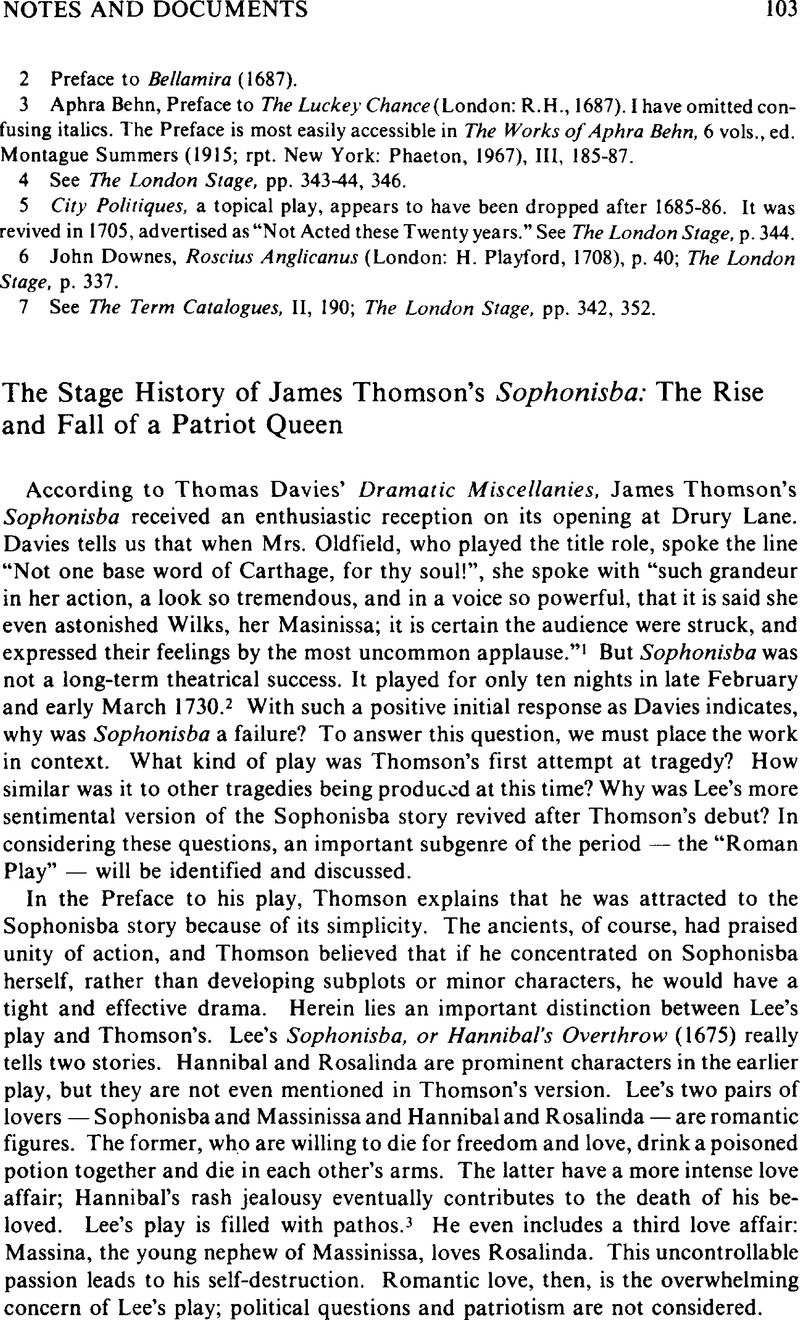No CrossRef data available.
Article contents
The Stage History of James Thomson's Sophonisba: The Rise and Fall of a Patriot Queen
Published online by Cambridge University Press: 07 July 2009
Abstract

- Type
- Notes and Documents
- Information
- Copyright
- Copyright © American Society for Theatre Research 1982
References
1 Davies, Thomas, Dramatic Miscellanies, 3 vols. (London: Printed for the Author, 1785), III, 465–466Google Scholar.
2 The indexes to volumes 1 & 2 of Part 3 of The London Stage (Carbondale: Southern Illinois University Press, 1961Google Scholar) incorrectly direct the reader to eighteen performances of Thomson's play running to 1745. Actually, it was Lee's version which enjoyed the continuing popularity. The error is perpetuated in Schneider, Ben Ross Jr.Index to The London Stage published in July 1979Google Scholar. We know it was Lee's play and not Thomson's by the title and cast of characters. Lee's play is called Sophonisba, or Hannibal's Overthrow and Thomson's is, simply, The Tragedy of Sophonisba. Thomson's play does not contain the story of Hannibal and Rosalinda, and, therefore, these characters do not appear in it.
3 See Rothstein's, Eric full discussion of the stress on pathos in this late heroic play in Restoration Tragedy (Madison: University of Wisconsin Press, 1967), pp. 79–83Google Scholar.
4 Thomson spells his hero's name with only one “s” in the first syllable: Masinissa.
5 See my chapter, “The Roman Play and Its Heroic Predecessors,” in Serious Drama and the London Stage: 1729–1739, Salzburg: University of Salzburg Press, 1981Google Scholar.
6 Winton, Calhoun, “The Roman Play in the Eighteenth Century,” StLI, 10 (Spring, 1977), 77Google Scholar. Winton sees the “Roman Play” as a genre and discusses its appearance throughout the century. He does not discuss its evolution or the factors contributing to its heyday in the 1730s.
7 Count obtained from listings in The London Stage, 1660–1800, Part 3: 1729–1747, 2 vols. (Carbondale: Southern Illinois University Press, 1961)Google Scholar.
8 Terms used by Barbeau, Anne T. in The Intellectual Design of John Dryden's Heroic Plays (New Haven: Yale University Press, 1970), p. 156Google Scholar.
9 See Cable's, Mabel Hessler “The Idea of a Patriot King in the Propaganda of the Opposition to Walpole, 1735–1739,” PQ, 18 (1939), 119–130Google Scholar.
10 Winton, p. 77.
11 Mallet's, David “Mustapha,” Three Centuries of Drama: 1700–1750, ed. Wells, Henry Willis (New York: Readex Microprint, 1953–1960)Google Scholar. Unless otherwise indicated, all references to plays are from the Readex Microprint Collection.
12 Robert James O'Brien, Jr., also sees Sophonisba as unusual and “unconventional” in her patriotic zeal. He discusses the various versions of the Sophonisba story in his unpublished dissertation, “The Originality of Thomson's ‘Sophonisba,’” University of Iowa 1973.
13 Thomson, James, The Tragedy of Sophonisba (London: A. Millar, 1730)Google Scholar.
14 Spectator #342, 2 April 1712. Quoted in Blanchard's, Rae “Richard Steele and The Status of Women,” SP, 26 (1929), 354Google Scholar.
15 The following performances are incorrectly attributed to Thomson in The London Stage: 




